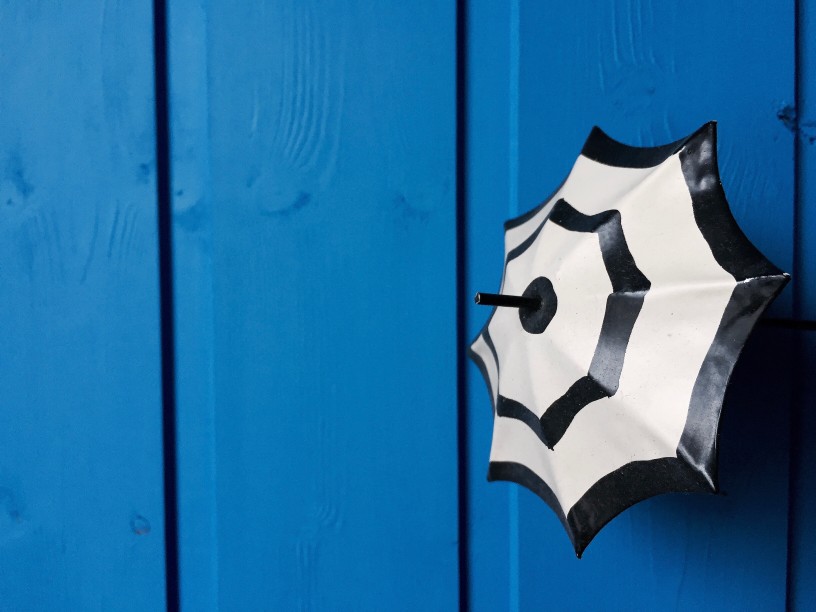
How To Master Predictive Retail Marketing
Years before Friday Night Lights, I loved watching Kyle Chandler in a show called Early Edition. The premise was simple — Chandler’s character received tomorrow’s newspaper today and spent the day trying to minimize the bad news. While the show was primarily a crime-fighting drama, it also raised some interesting questions, like when two catastrophes take place at once and you can’t prevent them both, which takes priority?
Looking at the challenges facing retail marketers today, there’s a lot that reminds me of Early Edition. Although no one has a crystal ball (or newspaper, as the case may be) that tells the future, technology has advanced to the point where it can help us make very accurate predictions about what’s to come. These predictions present enormous opportunities for retail marketers, but how do you use that information to take the right actions?
As Kyle Chandler’s character learned in Early Edition, knowing what’s to come is one thing — it’s really how you act on that knowledge that matters.
The Retail Marketers’ Early Edition: 4 Predictive Customer Insights + Tips to Make Them Actionable
What exactly is possible? And how can you take action based on what you learn? Consider the following four predictions and potential courses of action.
Prediction #1: Customer Lifetime Value
Retailers have long been able to calculate historical lifetime value for customers, but what if you could layer predicted lifetime value on top of that to understand the potential value of customers who have yet to purchase or the diminishing value from at-risk or lost customers? Today’s predictive technology makes that possible by taking into account signals like frequency of visits, customer sign ups, browsing history and similarity to other high value customers.
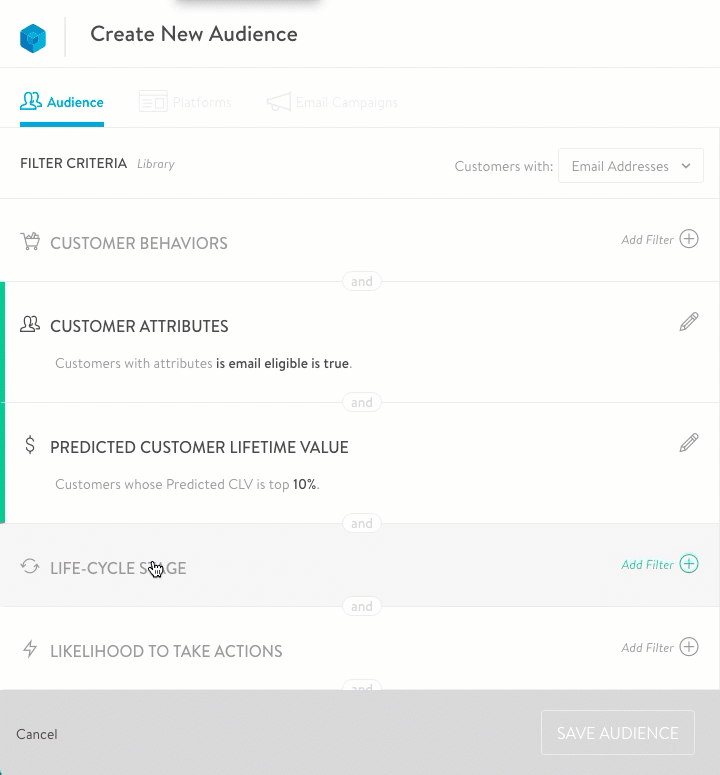
Once you have access to predictions about customer lifetime value, you can put that information to use in your marketing efforts by:
Nurturing VIPs
One of the most valuable courses of action for putting CLV predictions to work is to nurture your highest value customers to ensure they stay in that group and even increase their value where possible. For example, you might identify your top 10% of customers based on predicted lifetime value and develop targeted campaigns for this group that are designed to keep them purchasing and make them feel like VIPs.
Acquiring new high value customers
You can also use the information you have about existing high value customers to acquire new high value customers. Specifically, you might create a group of your top 10% of customers based on predicted lifetime value and sync that audience to Facebook to build a Lookalike audience.
Prediction #2: Lifecycle Stage
Lifecycle stage is another way to understand customer behavior that doesn’t require predictive technology but that such a lens can make exponentially more valuable. Traditionally, retailers have determined customer lifecycle stage based on static time periods (e.g. a buyer goes from active to at-risk after 90 days with no purchases and at-risk to lost after 120 days with no purchases). However, these standard numbers fail to take into account differences across customers and might leave you trying to win back frequent shoppers too late or infrequent shoppers too early.
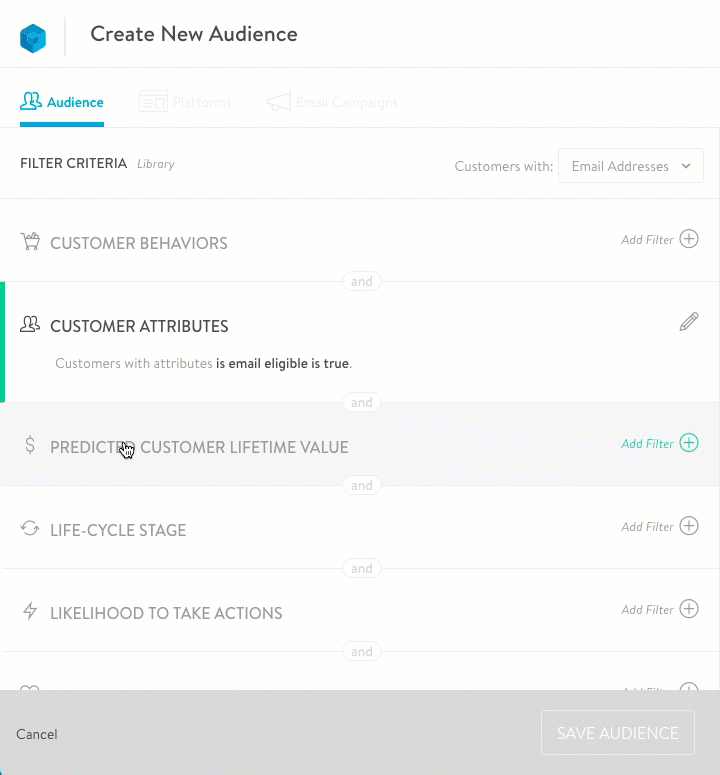
By using predictive technology, you can bucket customers into lifecycle stages based on their individual purchase cadence and the purchase cadence of similar customers. For instance, you can put this prediction to work in order to:
Improve efforts to save at-risk customers
Using predictive filters to build audiences of at-risk or lost customers makes it far more likely that you’ll target customers within the right window based on their shopping patterns. For example, if one customer normally makes a purchase every 30 days and hasn’t purchased anything in 40 days, you should treat her the same way as another shopper who normally makes a purchase every 90 days and hasn’t purchased anything in 100 days. When developing targeted campaigns to save these at-risk customers, consider using language like “we miss you” and offering an incentive to come back such as free shipping or a promo code.
Prediction #3: Likelihood to Take Action
This prediction is the closest to a crystal ball, as it indicates the likelihood that specific customers will take actions like unsubscribe from emails, open an email, click in an email and/or convert (i.e. make a purchase in the next 14 days). Understanding whether customers are very likely, somewhat likely or unlikely to take these actions can be extremely valuable in deciding the best way to engage with them.
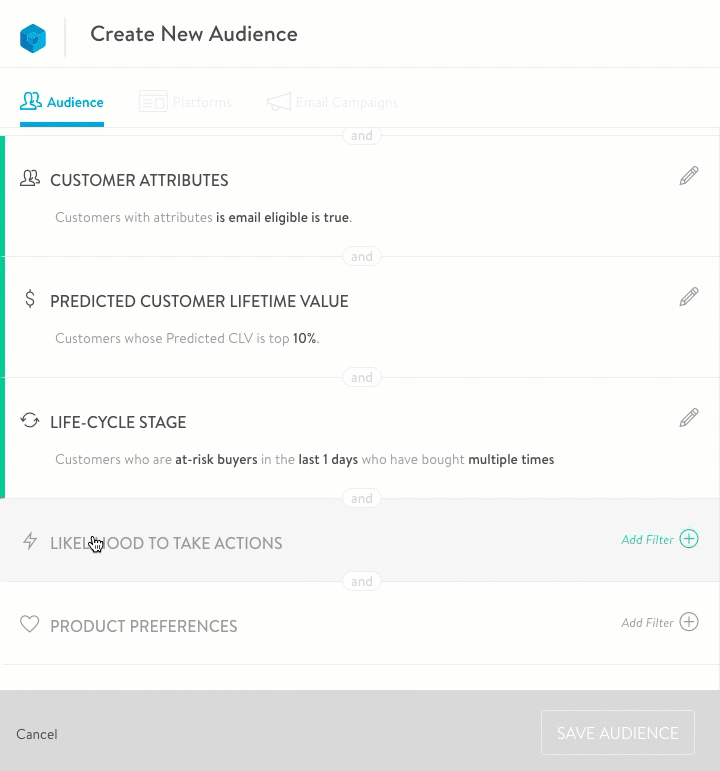
You can use these predictions to:
Strategically add touches to campaigns
Let’s say you send a product abandonment email and are debating whether or not to add a second touch. One option is to develop a second touch that sends only to audience members who received but did not open the first touch and have a high-to-medium likelihood to open emails. This approach gives you a greater chance that those customers will open the email while easing concerns about over-communication by eliminating customers who already opened the first touch.
Keep likely unsubscribers in the fold
A high unsubscribe rate can hurt your sender reputation and limit opportunities for engagement, ultimately contributing to lost customers. As a result, decreasing unsubscribes is always important, and this is another area where predicted likelihood to take action can help. Specifically, if you identify which customers are likely to unsubscribe from emails, you can take steps to prevent that from actually happening by targeting those customers on channels like Facebook or display advertising instead of email.
Prediction #4: Product Preferences
Finally, you can use predictive technology to better understand customers’ affinity toward certain product categories and discounts.
Looking at category preference, you can certainly make inferences based on past purchase and browsing behavior, but looking at these points alone often misses certain signals. Adding in behavioral data like co-view, co-purchase and co-cart information discovers less obvious information, which leads to more possible preferences.
Discount preference is another area where using past purchase data alone can work but poses limitations, largely because it leaves out non-buyers and those with minimal purchase history. Predictive technology can help overcome this limitation by combining purchase data with browse data. It can also take the ability to understand discount preference to the next level by distinguishing customers based on level of discount preference (e.g. full price buyers versus those who require a 20% discount versus those who require a 30-40% discount).
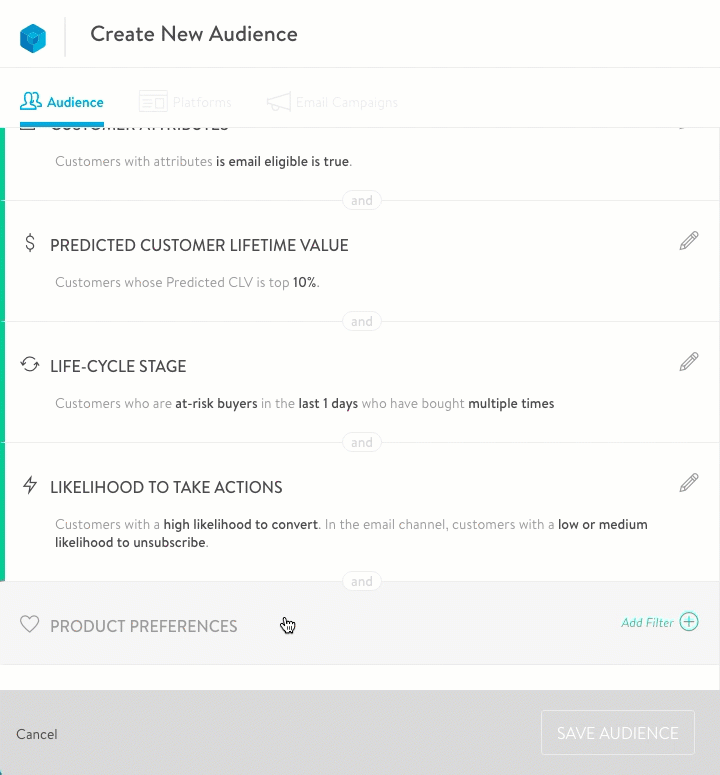
You can put this data to work by:
Targeting customers based on category preference
Whether you’re launching a new product, promoting a specific brand, hosting a category-specific event or anything else, targeting customers based on predicted category preference can prove extremely fruitful. For example, many retailers are using this information to expand the reach of their campaigns (e.g. by targeting customers who viewed certain products as well as those with a high affinity toward those products) without sacrificing personalization.
Maximizing margins based on discount preference
Offering discounts to all of your customers on a regular basis dilutes your margins and trains customers not to buy from you at full price. Additionally, it may even turn some shoppers off if they come to consider you a discount brand. Segmenting customers based on discount preference and then targeting them accordingly can help ease these challenges. The goal here is to show discount offers only to your discount buyers (or show lower offers to your full price buyers) in order maximize margins and retain your brand reputation. You can even personalize the offer for discount buyers based on how steep of a discount they require to make a purchase.
Which Decisions Are the Right Ones?
Bringing it back to Early Edition, one of the biggest lessons learned throughout the series was the importance of decision-making and the impact different decisions can have. Afterall, knowing the future comes with great power, and that power needs to be exercised responsibly.
When it comes to retail marketing efforts, a decisioning platform can not only deliver predictions like those outlined above, but it can also help you make decisions about how to act on that data in order to drive your desired outcomes.

P.S. If you’re looking for a new show to binge watch, I definitely recommend Early Edition.




